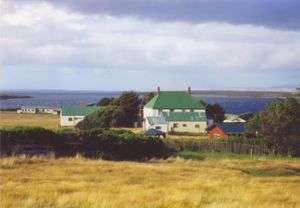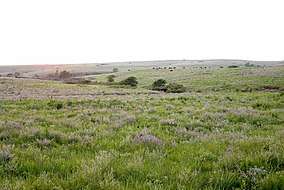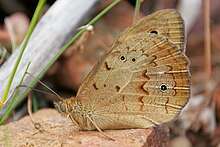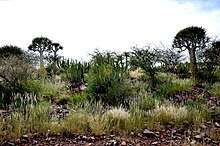Tussock (grass)
Tussock grasses or bunch grasses are a group of grass species in the family Poaceae. They usually grow as singular plants in clumps, tufts, hummocks, or bunches, rather than forming a sod or lawn, in meadows, grasslands, and prairies. As perennial plants, most species live more than one season. Tussock grasses are often found as forage in pastures and ornamental grasses in gardens.[1][2][3]
Many species have long roots that may reach 2 meters (6.6 ft) or more into the soil, which can aid slope stabilization, erosion control, and soil porosity for precipitation absorption. Also, their roots can reach moisture more deeply than other grasses and annual plants during seasonal or climatic droughts. The plants provide habitat and food for insects (including Lepidoptera), birds, small animals and larger herbivores, and support beneficial soil mycorrhiza. The leaves supply material, such as for basket weaving, for indigenous peoples and contemporary artists.
Tussock and bunch grasses occur in almost any habitat where other grasses are found, including: grasslands, savannas and prairies, wetlands and estuaries, riparian zones, shrublands and scrublands, woodlands and forests, montane and alpine zones, tundra and dunes, and deserts.


Fire resistance
In western North American wildfires, bunch grasses tend to smolder and not ignite into flames, unlike invasive species of annual grasses that contribute to a fire's spreading.[4]
Genera
- Some examples of genera:
- Brachypodium
- Calamagrostis
- Chionochloa
- Deschampsia
- Festuca
- Heteropogon – (tropical climates)
- Leymus
- Melica
- Muhlenbergia
- Nassella
- Stipa
Species
Australia

- Button grass — (Gymnoschoenus sphaerocephalus)
- Common tussock-grass — (Poa labillardierei)
- Grey tussock-grass — (Poa sieberiana)
- Red anther wallaby grass — (Joycea pallida)
- Triodia, formerly Plectrachne
New Zealand
Other New Zealand tussock grass:
- Chionochloa australis
- C. flavescens
- Festuca novaezelandiae
- Poa caespitosa
- P. colensoi
- P. foliosa
North America
- Bunch grasses:[5]
- Purple three-awn — (Aristida purpurea)
- Blue grama — (Bouteloua gracilis)
- Leafy reedgrass — (Calamagrostis foliosa) - (endemic to California)
- Pacific reedgrass — (Calamagrostis nutkaensis)
- Purple reedgrass — (Calamagrostis purpurascens)
- California oatgrass — (Danthonia californica)
- Hare's-tail cottongrass — (Eriophorum vaginatum)
- California fescue — (Festuca californica)
- Idaho fescue — (Festuca idahoensis)
- Red fescue — (Festuca rubra)
- Junegrass — (Koeleria macrantha)
- Giant wildrye — (Leymus condensatus)
- California melic — (Melica californica)
- Smallflower melic — (Melica imperfecta)
- Deer grass — (Muhlenbergia rigens)
- Foothill needlegrass — (Nassella lepida)
- Purple needlegrass — (Nassella pulchra) - (The state grass of California)
- Pine bluegrass — (Poa secunda)
- Prairie dropseed — (Sporobolus heterolepis)
- Salt couch grass — (Sporobolus virginicus)
- Eastern gamagrass — (Tripsacum dactyloides)
South America
- Tufted hair-grass — (Deschampsia cespitosa) - (up through North America)
- Serrated tussock — (Nassella trichotoma) - (common pasture weed in Australia)
- Tussac grass — (Poa flabellata)
- (Synonyms: Parodiochloa flabellata, Festuca flabellata, Dactylis caespitosa)

Africa
- Perennial tussock grass — (Heteropogon contortus) - (to Asia, Australasia, Oceania)
Europe
- Rope grass — (Ampelodesmos mauritanicus)
- Purple moor grass — (Molinia caerulea) - (to west Asia and north Africa)
See also
- List of Poaceae genera
- Tussock (disambiguation)
- Tussock grassland
Non-Poaceae tussocks
- Fibrous tussock-sedge (Carex appropinquata)
- Rough saw-sedge (tussock) (Gahnia aspera)
- Tussock sedge (Carex stricta)
References
- R.H. Groves, R.D.B. Whalley "Grass and Grassland Ecology in Australia" in Flora of Australia Volume 43 Poaceae 1: Introduction and Atlas, CSIRO Publishing, Canberra. "Tussock" grass implies a vertical orientation of the grass clump. In North American usage "Bunch grass" is more specific and defines a clumping, non-rhizomatous or non-stoloniferous growth form, vertical to splayed, and usually perennial with a deeper rooting system than other Poacea.
- Crampton, Beecher. "Grasses in California. University of California Press. Berkeley. 1974. ISBN 0-520-02507-5. p. 7 Walker, T.W. 1955 "The Ecology of Tussock Grasslands: Discussion" Proc. NZ Ecol. Soc 3:7 "One fifth of New Zealand carries tussock or bunch grass vegetation, more than other steppes, prairies, or grasslands of the world"
- Walker, T.W. 1955 "The Ecology of Tussock Grasslands: Discussion" Proc. NZ Ecol. Soc 3:7 "One fifth of New Zealand carries tussock or bunch grass vegetation, more than other steppes, prairies, or grasslands of the world"
- Ellsworth and Kauffman, 2010, Native Bunchgrasses Response to Prescribed fire in Ungrazed Grasslands
- "California Native Grasslands Association; access date: 6/9/2010". Cnga.org. 2012-07-20. Archived from the original on 2012-03-08. Retrieved 2012-12-23.
External links
- California Native Grasslands Association: Bunchgrass species & habitats: preservation & restoration
- http://www.landcareresearch.co.nz/resources/identification/plants/grass-key